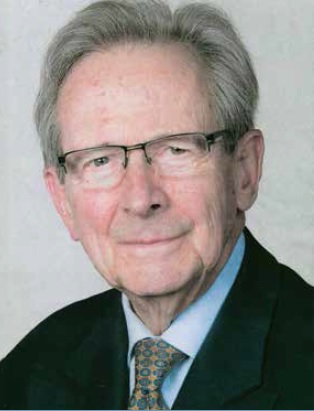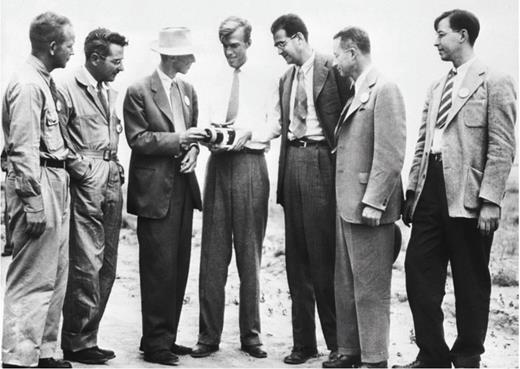The era of the atomic hematologists came to an end with the recent death of Professor Theodor M. Fliedner in Ulm, Germany, on November 9, 2015. Most readers of The Hematologist won’t know of this important chapter in hematology research led by a cadre of talented physician-scientists whose careers were profoundly influenced by the atomic age, much less how bikinis got their name or how to make beer taste the same glass to glass.
Fliedner was born in Hamburg in 1929 during an exciting time in physics and radiation biology in Europe and especially in Germany, with Albert Einstein, Leó Szilárd, Max Planck, Werner Heisenberg, Erwin Schrödinger, Herman Hemholtz, and others still active. In 1945, when Fliedner was 16, the United States dropped the atomic bombs on Japan to end World War II. This event had a tremendous influence on Fliedner, sparking his interest in the effects of ionizing radiation on animals and humans, especially the effects on hematopoiesis and hematopoietic stem cells. He studied medicine at the Universities of Göttingen and Heidelberg where he graduated summa cum laude. His doctoral thesis was titled “On the Pathogenesis of Acute Bone Marrow Atrophy in Rats After Whole Body Irradiation with Fast Electrons.” (How fast is “fast?” About 100,000 km/sec or about one-third the speed of light.) After graduation and postdoctoral training, he established a radiation hematology research unit in the Czerny-Hospital in Heidelberg.
In 1957, Fliedner went to the Brookhaven National Laboratory on Long Island where Dr. Eugene P. Cronkite and colleagues were working on radiation-related health issues. The United States had been conducting a series of nuclear tests at the Bikini and Enewetak Atolls in the Marshall Islands from 1946 to 1958.a The “Castle Bravo” test of 1954 was of unanticipated intensity (a 15-megaton thermonuclear bomb 1,000 times more powerful than the Hiroshima bomb). Unfortunately, about 300 Marshallese then living on the Rongelap, Ailinginae, and Utrik Atolls were exposed to radioactive fallout, principally iodine-131 (131I) and cesium-137 (137C). The Brookhaven team was involved in studying and treating the victims. This intrigued Fliedner immensely.
Development of atomic bombs and associated events played important roles in the identification of hematopoietic stem cells and unraveling the structure and kinetics of hematopoiesis. In 1945, the existence of hematopoietic stem cells was postulated but unproved. Fliedner, Cronkite, and others such as László Lajtha (Holt Radium Institute); Nicole Muller-Bérat Killman and Sven-Aage Killman (State Serum Institute, Copenhagen, Denmark); Dane Boggs (University of Pittsburgh); Frederick Stohlman Jr. (Tufts University); George Brecher (National Institutes of Health); and Maxwell Wintrobe, George Cartwright, John Athens, and Alvin Mauer (University of Utah) tackled the question in diverse research models such as giving animals and humans (mostly prisoners) tritiated thymidine (3H-thymidine) and 32P-labeled diisopropyl-fluorophosphate (DFP32). You would be arrested if you tried these experiments today. The thymidine for these experiments was provided by the Schwartz Chemical Company, which made yeast for beer brewers.b These radionuclides were injected and samples were taken for autoradiography and radiochemical assays. Autoradiography at that time required counting a few grains over hundreds of cell nuclei under a light microscope — tedious and demanding (imagine the worst Southern blot you have ever seen then multiply by 1,000). However, Fliedner was an expert, and as recounted by Cronkite in his 1989 oral history for ASH1989 oral history for ASH, he was often found in the lab at 4:00 a.m. laboring over an autoradiograph. He also studied bone marrow transplants in dogs given high doses of nitrogen mustard, in collaboration with Dr. E. Donnall Thomas, then at Cooperstown, New York. Using this model, Fliedner was able to show that a large proportion of hematopoietic stem cells were in the resting stage of the cell cycle.
This brings us to bone marrow transplants and the atomic bomb. Several U.S. physicians, including hematologists, were part of the Manhattan Project, which developed the atomic bombs detonated over Japan in 1945. These participants included Louis Hempelmann, who treated victims of a famous criticality accident at Los Alamos.c Immediately after World War II, the U.S. government, especially the Navy, which had nuclear submarine and aircraft carrier programs, was anxious to find ways to reverse the destruction of the bone marrow caused by exposure to high doses of ionizing radiations. The fear was that a nuclear attack by the Russians or a submarine accident would have devastating effects on military forces and on civilians. Hematologists were assembled at several sites including the National Institutes of Health and the University of Chicago. These efforts led to many important discoveries, including transplanting bone marrow cells into irradiated animals by Dr. Egon Lorenz and colleagues, and later into humans, as pioneered by researchers including Drs. E. Donnall Thomas, Joseph Ferrebee, and Georges Mathé, who with his colleagues in Paris treated five victims of a nuclear reactor accident in Vinča, Yugoslavia, in 1958. These radiation-related studies also led to the discovery of hematopoietic growth factors such as erythropoietin by Drs. Alan Erslev, Eugene Goldwasser, and others, and of myeloid growth factors by Drs. Leo Sachs and Dov Pluznik in Israel, Drs. Benjamin Bradley and Donald Metcalf and colleagues in Melbourne, and Dr. Malcolm Moore and colleagues in New York. Similar radiation protection programs were started in Europe, including in the Netherlands at the TNO, the Netherlands Organisation for Applied Scientific Research, by Dirk van Bekkum.
"Seven Atom Bomb Scientists Look over a Roengenometer at the Site of the Test Atom Bomb
"Seven Atom Bomb Scientists Look over a Roengenometer at the Site of the Test Atom Bomb
Much of what we know regarding the etiology of leukemias and related disorders also comes from studies done by the atomic hematologists. An increase in leukemia was first noted by Japanese hematologist Dr. Takuso Yamawaki in the late 1940s. This led to the establishment of the joint Japan-US Atomic Bomb Casualty Commission (now the Radiation Effects Research Foundation) in 1950 and the start of the Life-Span Study of 121,000 exposed persons and controls conducted by Japanese and American hematologists and epidemiologists. These data provide the most convincing evidence that ionizing radiations cause leukemias, and the dose-response relationships developed from these studies are the basis of most radiation protection guidelines. Hematologists such as Dr. Masao Tomonaga have spent their lives studying hematologic consequences of the atomic bombings.
Back to Fliedner. In 1963 he returned to Europe to become director of a EURATOM Institute for Radiation Hematology Research affiliated with the Faculty of Medicine at the University of Freiburg. He and his team studied the behavior of resting hematopoietic stem cells in rats using a model of continuous 3H-thymidine infusion. They were able to distinguish resting and dividing stem cells and their progeny and postulated that the resting stem cells were attached to the bone marrow endothelium. This prescient observation is the basis of much of the current research into the so-called stem cell niche (see Diffusion article in this issue by Dr. Jonathan Hoggatt), a field most people think was recently invented. Their model was also applied to other settings such as high-dose radiation exposures and leukemia. These experiments in rodents and dogs required a continuous 24- to 48-hour 3H-thymidine infusion, and the team often spent nights and weekends in the laboratory.
Fliedner’s interest in hematopoietic stem cells and radiation naturally led to studies of leukemia. He considered both sides of the issue: radiation as a cause of leukemia and using radiation to treat persons with leukemia. His team developed a technique of extracorporeal radiation as a therapy in persons with chronic lymphocytic leukemia (CLL), whereby blood was shunted into a chamber and exposed to ionizing radiations. Because lymphocytes are killed by radiation in interphase (G0 phase), blood counts fell precipitously. Interestingly, there were also off-target (abscopal) effects such as reduced spleen and lymph node sizes. For perspective, Drs. Kanti Rai and Rainer Storb treated persons with CLL with this technique when they were fellows. This approach was abandoned when anti-leukemia drugs were developed but is still biologically fascinating.
In 1967 the new Ulm University was inaugurated, with Fliedner as the youngest of eight founders. He became the director of the Department of Clinical Physiology and later the Dean of the Theoretical Faculty of Medicine. In 1983 he was appointed President of the University of Ulm. His research group, staffed by associates from Europe and elsewhere, focused on characterizing hematopoietic stem cells, especially after total body radiation in dogs. The team showed that large numbers of hematopoietic stem and progenitor cells could be collected by continuous-flow centrifugation, frozen, and stored for a future transplant. Although their focus was on radiation accidents, these techniques are currently used in auto transplants for cancer, especially lymphomas and myeloma. Fliedner was often the volunteer for these experiments — he loved long, tedious, technically demanding experiments.
In later life, Fliedner was best known internationally for his work on evaluating victims of radiation accidents. He chaired a European Consortium of Experts, which developed the 1981 publication Manual on the Acute Radiation Syndrome, which is widely used today. Quite remarkably, he developed a database of more than 800 detailed reports of radiation accidents. He also led a German research team studying the effects of space travel on bone marrow function in humans — studies continued by NASA and the Japan Space Agency.
Ted was active in scientific research throughout his life. Three years ago, he asked one of the authors (Dr. Gale) for details regarding a radiation accident in Israel. He wanted to review the pathology slides himself. In 2008, at age 79, he was writing letters to the editor of Blood, and in 2012, at age 83, he was first author of an article in the journal Dose-Response, “Hemopoietic Response to Low Dose-Rates of Ionizing Radiation Shows Stem Cell Tolerance and Adaption.”
Fliedner received many honors for his scientific contributions and leadership role in Europe. He was a man of vision and charisma, highly respected in the international scientific community. His evangelical attitude and passion for research quite probably reflected the missionary work of his forbearers, who were famous and highly regarded Lutheran clergyman. Many people who knew him superficially saw him as stern and uncompromising. But this was not his real character. During the 1968 student protests in Germany, he arrived at the University seminar room one morning to find students and technicians sitting on the conference table. When he politely inquired why, they said they were protesting. He asked, “Protesting what?” They said they weren’t really sure. He laughed: “Okay, I agree. Now let’s get back to work.”
Ted Fliedner’s death marks the end of a fascinating era in experimental and clinical hematology. The atomic hematologists gave us many important insights into hematopoiesis, drugs such as molecularly cloned hematopoietic growth factors, and clinical techniques such as protected environments and hematopoietic cell transplants.
a The bikini bathing suit, designed by French engineer Louis Réard, is named for the Bikini Atoll. The suit was introduced to the public four days after the 1st A-bomb test was announced. At that time, attractive women were called bombshells, and a competing swim suit designed by Jaques Heim was called the Atome.
b Beer drinkers (we are told), in contrast to wine drinkers, want every glass of beer to taste the same. However, yeast used to ferment the grains continually mutate, potentially changing the beer’s taste. Schwartz, a chemist, developed a process to remove mutant yeast which he saved. Because these yeast contain large amounts of Dann, there was plenty of thymidine available to label with 3H.
c More on this in the 1989 movie Fat Man and Little Boy and The Making of the Atomic Bomb by Richard Rhodes.
Competing Interests
Dr. Gale and Dr. Hoelzer indicated no relevant conflicts of interest.


